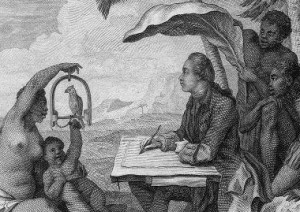Pierre Sonnerat (1748 – 1814) was a French natural scientists and explorer. Betwen 1774 and 1781 he traveled China, among others. His experiences were published in a 1782 narrative. Therein he also described Chinese martial arts-related techniques. These are reminiscent of some of the more Chinese-influenced martial arts system still found in Okinawa today. For instance, the following description might as well refer to the kata called Sanchin, and Hojo-undo.
« Les Chinois sont bien faits, lestes & forts dans le badinage ; mais dans une dispute sérieuse, toutes leurs petites supercheries disparoissent, la crainte & la lâcheté l’emportent & les obligent à prendre la fuite. Dès leur bas âge, ils s’étudient à lever des poids de cent & cent cinquante livres, jusqu’à ce qu’ils puissent les élever au-dessus de leur tête, à bras tendu. Sept à huits sacs remplis de terre & pendus au plancher, sont encore des champions contre lesquels ils s’exercent à se battre. Ils se mettent dans le milieu des différens sacs, les agitent & tachent d’en éviter les coups ; ils ont une manière de roidir leurs muscles, qu’ils appellent se rendre dur ; & quand ils luttent, ils s’en servent avantageusement contre leur adversaire, parce qu’ils roidissent la partie menacée du coup, & celui qui le donne se fait plus mal qu’il n’en fait à celui qui le reçoit. »
In the very first part, were Sonnerat says that the Chinese run away when push comes to shove, is an example of colonialist arrogance and cultural eurocentrism of the time. It is similar to today, when we still interpret karate – espcecially historical karate – in Western terms. It is followed by a part that deals with bag and weight training; I think everyone knows respective practices.
In this connection I cannot but wonder how much today’s acquisition of martial arts is comparable to the era of colonialism, trade, and science in sense of a Western cultural centrism towards Japanese martial arts. At the same time I cannot but wonder whether the Japanese martial arts turned the tables on the West in sense of a “reverse cultural centrism”.
The part that might be considered as to related to Sanchin-like practice translates to English roughly as follows:
“In brawls the Chinese use the technique of stiffening and toughening (temper, harden) the part of the body upon which they expect to receive the blow, by instantly tightening the muscle, so that the enemy feels the impact more than the one who receives it.”
BTW, in the late 18th century Sonnerat’s narrative was also translated to German:
„Die Chinesen brauchen bey Prügeleyen den Kunstgriff, die Stelle des Körpers, worauf sie den Schlag erwarten, steif zu machen und abzuhärten, indem sie augenblicklich den Muskel straff machen, so daß der Gegner den Schlag mehr empfindet, als der, dem er zugetheilt war.“
© 2015, Andreas Quast. All rights reserved.

